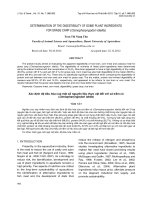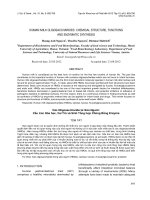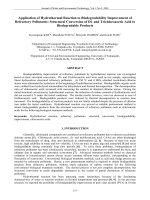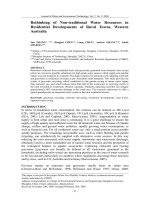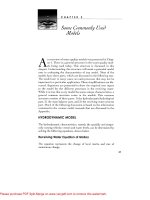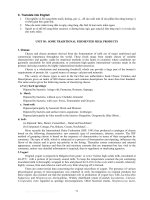SOME TRADITIONAL FERMENTED MILK PRODUCTS
Bạn đang xem bản rút gọn của tài liệu. Xem và tải ngay bản đầy đủ của tài liệu tại đây (342.69 KB, 19 trang )
71
C. Translate into English
1. Thịt nghiền có bổ sung thêm muối, đường, gia vị... để sản xuất một số sản phẩm làm tăng hương vị
và thời gian bảo quản thịt.
2. Nhu cầu nước mắm trong dân ta ngày càng tăng, đặc biệt là loại nước mắm ngon.
3. Người ta có thể bổ sung thêm caramel, rỉ đường hoặc ngô, gạo rang kỹ làm tăng mùi vị và màu sắc
cho nước mắm.
UNIT 50 : SOME TRADITIONAL FERMENTED MILK PRODUCTS
1. Cheese
Cheese and cheese products derived from the fermentation of milk are of major nutritional and
commercial importance throughout the world. These foods range from simple cheese of variable
characteristics and quality, made by empirical methods in the home in countries where conditions are
generally unsuitable for milk production, to consistent high quality international varieties made in the
primary dairying countries by highly industrialized modern practices.
Cheese is a wholesome and interesting foodstuff, which can provide a large part of the human’s
requirements of protein, fat - a good source of energy- calcium and minerals.
The variety of cheese types is seen in the fact that one authoritative book Cheese Varieties and
Descriptions gives an index of 800 cheese names and contains descriptions for more then four hundred.
The same source gives the following means of classifying cheese.
a.Very hard (grating):
Ripened by bacteria: Asiago old, Parmesan, Romano, Sapsago,
b. Hard:
Ripened by bacteria, without eyes: Cheddar, Granular
Ripened by bacteria, with eyes: Swiss, Emmentaler and Gruyere.
c. Semi-soft:
Ripened principally by bacterial: Brick and Munster.
Ripened by bacteria and surface micro-organisms: Limburger,
Ripened principally by blue mould in the interior: Roquefort, Gorgonzola, Blue Stlton ..
d. Soft:
(a) Ripened: Brie, Butter, Camembert, , Hand and Neufchatel
(b) Unripened: Cottage, Pot, Bakers, Cream, Neufchatel …
More recently the International Dairy Federation (IDF, 1981) has produced a catalogue of cheese
based on the following characteristics: raw material; type of consistency; interior; exterior. The IDF
method of grouping cheese is based on the sequence of characteristics in terms of their recognition by
consumer. The type of milk, which is subjected to a process of fermentation and ripening, influences the
flavor of the cheese and is given top priority in the listing. Thereafter comes consistency and internal
appearance, external features and then fat and moisture contents that are important but less vital to the
consumer, unless very detailed information is required, than to regulatory or marketing agencies.
2.Yogurt
Original yogurt is prepared in Bulgaria from goats’ or cows’ boiled, high solids milk, inoculated at
40-45°C with a portion of previously soured milk. To keep the temperature constant the pot containing
inoculated milk is thoroughly wrapped in furs and placed for 8-10 h in the oven until a smooth, relatively
highly viscous, firm and cohesive curd with very little wheying off is formed.
There are controversial data concerning the original microflora of yogurt. The presence of various
physiological groups of microorganisms was reported in early investigations on original products but
these reports also pointed out that the predominant role in production of yogurt lays with Lactobacillus
bulgaricus and Streptococcus thermophilus. Widely distributed yeasts (Candida mycoderma, C.krusei,
C.tropicalis) were regarded as spoilage microorganisms. Other bacterial strains, Streptococcus lactis,
72
Str.lactis subsp. Diacetylactis, Leuconostoc spp., Str.lactis var. taette (slime producer), were regarded as
supplementary microflora.
Rasic and Kurmann (1978), summarizing the findings concerning the original yogurt microflora,
divided it into three groups:
Essential microflora - consisting of Streptococcus thermophilus and Lactobacillus bulgaricus.
Non-essential - represented by homofermentative lactic acid strains other than in group (a) and by
heterofermentative lactic acid bacteria. Some of them may be used beneficially for supplementing the
original microflora: for example, Lactobacillus acidophilus, Bifidobacterium bifidum, Propionibacterium
shermanii, Streptococcus lactis subsp. Diacetylactis.
Contaminants: yeasts, moulds, coliforms and other undesirable microorganisms.
The metabolic activity of yogurt bacteria results in a considerable increase in cell numbers. The
total count of viable yogurt bacteria ranges between 200 and 1000 million per ml of fresh yogurt, but
decreases during subsequent storage.
Finished yogurt is thus the end product of a symbiotic culture of Streptococcus thermophilus and of
Lactobacillus bulgaricus growing at temperatures in the range 40-45
0
C.
Faster growth of streptococci at the beginning of fermentation brings about accumulation of
moderate amounts of lactic and acetic acids, acetaldehyde, diacetyl and formic acid, availability of format
and the growth of Lactobacillus bulgaricus. Yogurt is finished at pH 4.2 - 4.3.
Lactobacillus bulgaricus demonstrates a much stronger proteolytic activity than does Streptococcus
thermophilus. By liberating from milk proteins a number of amino acids, stimulation of growth of
Streptococcus thermophilus occurs. The content of liberated amino acids is considerably higher than that
are necessary to meet the nitrogen requirement of Streptococcus thermophilus, and hence a considerable
increase occurs in the free amino acids content of finished yogurts. Of the individual amino acids
glutamic acid and proline are present in the highest amounts.
Yogurt bacteria, particularly Streptococcus thermophilus exhibit a marked sensitivity to antibiotics
and other inhibitory substances present in milk. Their destruction may be also caused by bacteriophage.
Yogurt, as a product, is relatively highly viscous, firm and cohesive. Its body characteristics are
greatly influenced by the careful regulation of production conditions. Top quality yogurt is smooth,
without grittiness or granules and without effervescence. It is highly acid product.
The quality of strains used in starters is of particular importance. The characteristic flavor is
contributed mainly by lactobacilli producing lactic acid and acetaldehyde. But the complexity of flavor is
secured by the balanced level of many by-products represented by other carbonyl compounds as well as by
the amino acids released into milk.
Yogurts exhibit an antagonistic effect against a number of pathogenic and saprophytic organisms
but this effect shows many variations depending on the bacterial strains used, and on their particular
antagonistic properties.
EXERCISES
A. Read and translate into Vietnamese
empirical methods, a wholesome, recognition, be wrapped, furs, cohesive curd, controversial data,
investigation, point out, yogurt lay, spoilage, essential microflora, subsequent storage, a symbiotic
culture, bacteriophage, grittiness, effervescence, the complexity, an antagonistic effect, pathogenic,
saprophytic organisms
B. Answer the following questions
1. What is the semi-soft cheese producing from cow milk?
2. How many types of cheeses are classified in the world?
3. What is yogurt?
4. How many groups of original yogurt microflora are divided into a symbiotic culture?
5. Can you describe some useful effects of yogurt.
73
C. Translate into English
1. Fomát là một loại thực phẩm được ưa thích vì nó có thể cung cấp phần lớn nhu cầu protein, chất
béo và nguồn năng lượng cho con người.
2. Sữa chua có nguồn gốc sản xuất ở Bungari từ sữa bò, sữa dê, được giữ ở nhiệt độ ổn định 40 - 45
0
C
với giống sữa chua giống của đợt trước.
3. Tổng lượng vi khuẩn sống sót trong sữa chua có từ 200 - 1000 triệu/ ml sữa chua tươi nhưng giảm
đáng kể trong thời gian bảo quản tiếp theo.
UNIT 51 : GENERAL PRINCIPLES FOR INDUSTRIAL PRODUCTION OF MICROBIAL
EXTRACELLULAR ENZYMES
Very little specific information has been presented in the public domain that details the particular
methods applied to the production of any one enzyme. This is largely due to the extremely competitive
state of enzyme production and marketing resulting in very real differences in the way each producer
arrives at a cost-effective process for his products.
There are some main steps of enzyme production as follow:
1. The Production Strain
Some principal microorganisms that have found acceptance for production of industrial enzymes.
The species listed are generally considered to present the least risk of toxin production during
fermentation as well as being non-pathogenic to man.
Bacillus species are comparatively easy to isolate and despite the problems associated with spore
formation, many have been isolated as non-sporing strains. The Aspergilli are similarly placed amongst
the fungi, although the formation of conidial spores is desirable for the ease of inoculation of large-scale
fermentations. In every case, the strain selected for production will have a highly improved enzyme
producing capability compared with the wild strains and will have undergone stringent screening to
ensure that it does not produce toxins or antibiotics in order to meet increasingly stringent standards for
food applications of enzyme product.
2. Fermentation
The choice of fermentation method lies between ‘solid state’ (which is also called semi-solid) and
submerged or ‘deep’ fermentation. In rare cases the organism will dictate the choice by virtue of either
non-production or low yields by one method. Generally, however, the nature of the final enzyme product
and its designated performance objective determine the method. Enzymes from solid state cultivation are
generally found to be complex mixtures, often including amylase, protease, lipase and non-starch
carbonhydrases in definite proportions that are regulated by the cultivation. If a high level of a single
activity is desired, it is commonly produced by submerged fermentation.
Submerged ‘deep’ fermentation has been adopted as the most economic route for the preparation of
bulk industrial enzymes. Suspended insoluble nutrients and inexpensive additional sources of nitrogen,
phosphate and trace elements in soluble forms are used. The medium selected must support good growth
of the microorganism and be as inexpensive as possible. Soybean meal, starch hydrolysates and corn
steep liquor dominate the list of typical ingredients. The specific additional growth the enzyme synthesis
stimulating requirements are determined for each organism selected as a production strain.
Despite great developments of sophisticated instrument monitoring of research fermentations, the
industrial enzyme fermentation system utilizes basic but large fermentation equipment. Main vessels can
reach 150 m
3
in practice and they are an essential feature of the economics of bulk processing. Controls to
monitor pH, temperature and in some cases dissolved oxygen, are typical. Where the use of suspended
medium is encountered, it is often necessary to have efficient foam detection and antifoam treatment as an
extra control facility. Bulk medium is generally prepared separately in tanks that allow pH adjustment and
74
direct or heat exchange steam sterilization. Most systems pump the sterile medium into the fermentation
vessels that have been previously sterilized with live steam.
3. Broth Purification
The bran extract or fermentation broth contain the enzyme, residues of the suspended medium
components, the soluble medium components and the cells of the fermented microorganism. Initially, the
solids are removed by filtration or centrifugation aided by the use of flocculents to increase the particle size,
e.g. calcium salts, polyelectrolytes and aluminum salts typified by modern water treatment methods. It is
common to load a proportion of diatomaceous earth or other filter aid into the stirred broth before filtration,
which is most often performed on rotary vacuum filters. Where centrifugation is adopted, the high-speed
disc machine with continuous operation is preferred.
Concentration of enzyme liquids is a compromise between energy efficiency and activity loss. Low
temperature vacuum evaporation is most commonly applied to stable enzymes and ultrafiltration is used
for the more sensitive products, since it can successfully be performed at temperatures around 5
o
C.
Purification is usually necessary both to eliminate microorganisms and to reduce the preparation to
the lowest practical contamination with other enzymes produced by the fermentation. Polishing and germ
filtration steps are able to remove microorganisms and a series of precipitations may be performed to
select the desired enzyme. The addition of an inorganic salt such as sodium or ammonium sulfate to a
specified concentration will precipitate a range of proteins which may include the desired enzyme or
leave it in the soluble phase. Further solution and precipitation stages may be performed with different
concentrations of precipitant to achieve a desired purification. Organic solvents that lower the dielectric
constant of the system and so reduce the solubility of proteins are also used to precipitate enzymes. The
most effective treatments are performed using chilled solvents and adding them to the aqueous broth,
whose pH has been adjusted to the isoelectric value for the enzyme being processed.
Purified liquid enzymes are standardized by dilution and the diluents generally include stabilizing
salts, polyalcohols or sugars and any permitted preservatives deemed necessary. In the limited
applications where a dry enzyme product is required, it is now recognized that the spray drying should
include a granulation to minimize the potential hazards of dusty, dry products. The inhalation of any
protein dust is likely to increase the risk of allergic response to further exposures to the same protein and
it is recommended to take full precautions when handling enzymes in powder form. Granulation will
follow standardization with acceptable materials such as sugars, starch, flour or inorganic salts.
EXERCISES
A. Read and translate into Vietnamese
conidial spores, stringent screen, foam detection, antifoam treatment, bulk medium, pH adjustment, bran
extract, fermentation, diatomaceous earth, rotary vacuum filters, germ filtration steps, precipitant, organic
solvents, dielectric constant, chilled solvents, standardized, spray drying, a granulation, hazards of dusty,
dust, allergic response, exposures, precautions
B. Answer the following questions
1. What are the main steps for the production of enzymes?
2. What is the advantages of microbial extracellular enzymes?
3. What are different methods of fermentation in the production of enzymes?
4. What are the main factors for choosing the Micoorganisms in the production of enzymes?
5. What is the purpose of broth purification?
C. Translate into English
1. Tuyển chọn một chủng vi sinh vật thích hợp là bước quan trọng đầu tiên cho quá trình sản xuất một
sản phẩm của công nghệ sinh học.
2. Một loại enzim được sử dụng trong công nghiệp thực phẩm cần có các đặc tính ổn định và không
tạo độc tố hoặc các sản phẩm phụ không mong muốn khác.
75
3. Phương pháp nuôi cấy chìm cần kiểm tra và điều chỉnh pH, nhiệt độ, ôxy hòa tan và dùng cả tác
nhân khử bọt.
UNIT 52 : CITRIC ACID (C
6
H
8
O
7
)
History
Citric acid is on of the most widely spread plant acids occurring as a natural constituent of citrus
fruits, pineapples, pears, peaches and other fruits and tissues.
The importance of “natural” citric acid has, however, greatly diminished since the development of the
fermentation process from sugar solutions. Wehmer, in 1893, described the production of citric acid by mould
fermentation. He designated the moulds as Citromyces and later reported that Penicillium and mucor could
produce similar reactions. But it was left to Currie, in 1917, to point out that strains of Aspergillus niger were
in fact best for the fermentative production of citric acid.
Properties
Although sugar solutions of various origins have been used to produce citric acid, for production of
an industrial scale sucrose and technical glucose remain the easier raw material, with maltose and
molasses as second best.
Beet molasses has had more success than blackstrap or invert cane molasses, but in the USA these
last two raw materials have been used for a large number of years. In most cases a certain amount of
oxalic acid is produced together with the citric acid.
It is not possible to delve here into many theories, which have been advanced about the citric acid
fermentation process. The Krebs or tricarboxylic acid cycle offers a partially suitable solution, indicating that
pyruvic acid from glucose yields acetyl ~ SCoA, which condenses with oxalo acetic acid, already formed in
the cycle, to produce citric acid.
Surface fermentation
We refer to the process as practiced at Ladenburg, Germany, in 1945. The plant had a capacity of 6-10
tons per day of calcium citrate. The raw material is beet molasses (48-50% sugar) obtained preferably from
sugar factories producing raw sugar. Improved strains of Aspergillus niger, with spores grown on molasses
agar, are used as inoculum.
‘The molasses is diluted to 30% sugar, adjusted to pH 6.5 ,aided with sulfuric acid, treated with
ferrocyanide and phosphoric acid, heated to 100
0
C for 1h for sterilization, and diluted to 15% sugar for
fermentation. The amount of phosphoric acid should be sufficient to bring the P
2
O
5
content of the
molasses to at least 0.02 %. The treated molasses is then run into the fermentation chambers, each
containing 80 aluminum trays 2 x 2.5 m x 15 cm deep. They are filled to a depth of 8 cm with the diluted
molasses, inoculated by means of spores blown in with the air supply and incubated for 9-11 days at
30
0
C.
The mould mats are removed by hand and extracted, 15% of the total yield being obtained from the
washing. The fermentation liquor is heated, treated with calcium oxide at a pH of 8.5, and the precipitated
crude calcium citrate filtered off. The air supply to the fermentor chambers is “sterilized” by passing
through a 5-cm-thick cotton filter impregnated with salicylic acid, then moistened to 40% relative
humidity at 30
0
C. The air supply is changed at the rate of one volume of air per volume every 4.3
minutes”.
Before each fermentation cycle, the fermentation chambers are sterilized by washing with 1%
caustic soda, then with water, then with 6% formaldehyde. Finally, sulfur dioxide is blown into the
chambers with the air stream. The yield claimed is 70% of the added sugar, presumably as monohydrate
citric acid.
Johnson when commenting on this process as practiced at the Benckiser Works at Ladenburg, drew
attention to the inadequate provisions for sterilization and asepsis, although it is claimed that very little
trouble was experienced from contamination.
Submerged fermentation
Compared with surface fermentation, submerged fermentation should have many advantages:
higher yields, shorter cycle, simpler operation, lower labor and maintenance costs, minimum
contamination, etc.
A factory employing submerged fermentation started operation in the USA in 1951 but no precise
data has so far been published on its operative procedure.
76
The published data from patents and research laboratories show a tendency to use mould strains
different from A.niger: A.fimaricus, japonicus and wentii have been mentioned. Aeration and agitation of
the medium as essential, and with cane molasses as raw material the addition of methanol seems greatly
beneficial.
The following description is based on a report from Taiwan by S.F.Lin. Clarified molasses from
carbonation factories was diluted to 20
0
Brix to bring the sugar content to 13-14% of total sugars and
added with Phosphoric acid (0.0005%) and ammonium sulfate.
After sterilization, the medium was adjusted to pH 6.0 and 3% of methanol was added 8 hours after
inoculation. The strain of Aspergillus niger used was ML-516 and 2% of inoculum was added. The
medium was kept under aeration and agitation at 29
0
C during fermentation, which was completed in
about 8 days. The reported yield of citric acid was 60% of total sugar used.
A reported from Mexico by Sanchez-Marroquin indicates the following medium as optimum for
the production of citric acid from cane molasses with A.niger in submerge cultures. Molasses diluted to
10% sugar concentration is treated with potassium ferrocyanide and the following nutrients are added:
ammonium nitrate (0.15%), zinc sulfate (0.0044%), monopotassium phosphate, KH
2
PO
4
(0.02%); corn
steep liquor (0.02%); and ethanol (3.5%) or methanol (3%). The medium is adjusted to an initial pH of 6.5-
7.0, kept under aeration and agitation with a fermentative temperature of 30-32
0
C after receiving a suitable
vegetative inoculum of 1.5%. Yields of up to 68% are reported.
EXERCISES
A. Read and translate into Vietnamese
diminish, designate, molasses, blackstrap, cane molasses, beet molasses, delve, surface fermentation,
mould mats, impregnate, inadequate provisions, asepsis
B. Answer the following questions
1. Give the definition of citric acid.
2. What are the main raw materials for production of citric acid?
3. Describe the fermentation chambers for production of citric acid by surface fermentation method.
4. What are the main advantages of submerged fermentation of citric acid?
5. Tell some main operations of simplified flow sheet of citric acid.
C. Translate into English
Rỉ đường củ cải được dùng để sản xuất axit xitric tốt hơn rỉ đường mía và dịch nước mía ép ra.
Trong các phòng nuôi cấy bề mặt, mỗi phòng chứa khoảng 80 khay nhôm hoặc inox có kích thước 2 x
2,5 m x 15 cm bề sâu và dịch rỉ đường pha loãng ngập sâu khoảng 8 cm.
Môi trường được điều chỉnh đến pH ban đầu là 6,5-7,0 giữ nhiệt độ 30-32
0
C, khuấy trộn và sục khí vô
trùng liên tục khi lên men axit xitric theo phương pháp nuôi cấy chìm.
77
UNIT 53 : PLANT AND ANIMAL CELL CULTURES
Introduction
In the last few years, the interest of biotechnology in plant and animal cell cultures has dramatically
expanded. The increasing importance of cell cultures can be recognized from the fact that in books on
biotechnology space is being made more and more frequently for information on higher cells and that
biotechnological symposia now always devote some sections to biological and technological aspects for
plant and animal cell cultures.
The aim of this section to acquaint the leader with the nature, the maintenance, the problems, and
the literature of plant and animal cell cultures. Many aspects must necessary be left out of consideration.
However, we hope that our choice gives the reader a clear overview of the present state, the possibilities,
and the difficulties of using higher cell in biotechnology. Plant and animal cell cultures in effort so
greatly in their characteristics that are two systems are treated separately.
Plant cell cultures
General
The number of laboratories dealing with plant cell cultures has increased continuously in the some
few years. In 1972, 940 scientists from 41 countries belonged to the “international association for plant
tissue cultures”. In 1980, an Association already had more than 2000 members in 63 countries. An
International congress for plant cell cultures is held by the group every four years. The programs of these
congresses best reflect the fact that work with plant cells is being performed for many different purposes.
For example, plant cell cultures are an excellent tool for answering some basic biological questions. As
we will show, answers to basic questions are as necessary as applied research for planning a broad
biotechnological utilization of plant cell cultures in industry and agriculture. Commercial application of
cell cultures is seen, in particular, in the production of important natural compounds and in the
improvement of crop plants. These two areas cannot be considered equally here; the product-oriented
aspect of plant cell cultures will be emphasized more, since biotechnological - at least in the past - has
dealt to some extent with fermentation and product recovery. The decision to favor product-oriented cell
culture research does not mean that this area will become accessible to a broader commercial application
earlier. On the contrary, at the present time it appears that the improvement of useful plants through cell
culture technique may be achieved before the production of natural compounds from cell cultures at
economically acceptable cost.
For two reasons it seems necessary to give an introduction into working with plant cell cultures
before describing the biotechnological aspects. First, the field is uncharted territory for many
biotechnologists, and, second, at the present time there is no collection of plant cell cultures from which
definite lines can be obtained. Consequently, as a rule, in most cases one has to establish the required cell
culture oneself.
Work with plant cell cultures
Equipment of a cell culture laboratories: Since plant cell cultures grow much more slowly than
many microorganisms, the highest commandment in handling plant cell cultures is sterile working. A cell
culture laboratory should therefore have available a clean bench with laminar air flow. Plant cell cultures
should be maintained under constant conditions. Cultivation may take place in climatized chests, or still
better, in climatized rooms. In most laboratories, plant cultures are maintained both on agar media and in
liquid media. Suspension cultures must be shaken continuously on shaking machines for continuous
operation. The biosynthetic productivity of a culture is frequently affected by light. In order to test these
effects on the cultures, different light fields should be available for such experiments. Anyone requiring
detailed information on the construction and equipment of a cell culture laboratory may be referred to an
article
Media for plant cell cultures
The choice of medium is a device factor for setting up a culture and for the growth and
biosynthetic productivity of a cell culture. The cells of most plants can be grown on definite synthetic
media. Only a few cases have additives such as yeast extract, casein hydrolysate, and coconut milk
proved to be necessary. An outstanding position has been achieved by the MS medium according to
